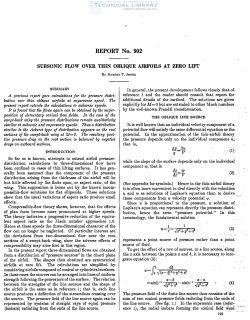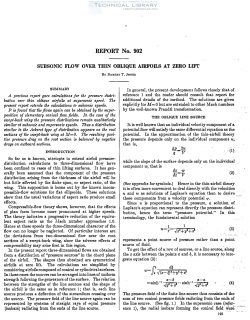naca-report-902

- Version
- 197 Downloads
- 807.26 KB File Size
- 1 File Count
- August 31, 2016 Create Date
- August 31, 2016 Last Updated
National Advisory Committee for Aeronautics, Report - Subsonic Flow Over Thin Oblique Airfoils at Zero Lift

A previous report gate calculations for the pressure distri-
bution over thin oblique airfoils at supersonic speed. The
present report extends the calculations to subsonic- speeds.
If its found that the flows again can be obtained by the super-
position of elementary conical flow fields. In the case of the
swept—back wing the pressure distributions remain qualitatively
similar “at subsonic and supersonic speeds. Thus a distribution
similar to the Ackeret type of distribution appears on the root
sections of the swept-back wing at 1!! =0. The resulting posi-
tire pressuredrag on the root section is balanced by negative
drags an outboard sections.
So far as is known, attempts to extend airfoil pressure-
distribution calculations to three-dimensional flow; have
been confined to cases of thin lifting surfaces. It has gen-
erally been assumed that the component of the pressure
distribution arising from the thickness of the airfoil will be
but little affected by the finite span, or aspect ratio, of the
wing. This supposition is borne out. by the known incom~
pressible—fiow solutions for flat ellipsoids. These solutions
show that the usual variations of aspect ratio produce small
effects.
Compressible—flow theory shows, however, that the effects
of plan form become more pronounced at higher speeds;
The theory indicates a progressive reduction of the equiva-
lent aspect ratio as the Mach number approaches 1.0.
Hence at these speeds the three-dimensional character of the
flow can no longer be neglected. Of particular interest are.
the deviations from two-dimensional flow near the root
sections of a swept-back Wing, since the adverse effects of
compressibility may arise first in this region.
In the present report three-dimensional flows are obtained
from a distribution of “pressure sources” in the chord plane
of the airfoil. The shapes thus obtained are symmetrical
airfoils at zero lift. The calculations are simplified by
considering airfoils composed of conical or cylindrical surfaces.
In these cases the sources can be arranged into lines of uniform
strength following the generators of the surface. The relation
between the strengths of the line sources and the shape of
the airfoil is the same as in reference 1; that. is, each line
source produces a deflection of the streamlines crossing over
thesource.
| File | Action |
|---|---|
| naca-report-902 Subsonic Flow Over Thin Oblique Airfoils at Zero Lift.pdf | Download |

Comment On This Post